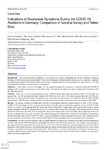Indications of Depressive Symptoms During the COVID-19 Pandemic in Germany: Comparison of National Survey and Twitter Data
Cohrdes, Caroline
Yenikent, Seren
Wu, Jiawen
Ghanem, Bilal
Franco-Salvador, Marc
Vogelsang, Felicitas
Background: The current COVID-19 pandemic is associated with extensive individual and societal challenges, including challenges to both physical and mental health. To date, the development of mental health problems such as depressive symptoms accompanying population-based federal distancing measures is largely unknown, and opportunities for rapid, effective, and valid monitoring are currently a relevant matter of investigation.
Objective: In this study, we aim to investigate, first, the temporal progression of depressive symptoms during the COVID-19 pandemic and, second, the consistency of the results from tweets and survey-based self-reports of depressive symptoms within the same time period.
Methods: Based on a cross-sectional population survey of 9011 German adolescents and adults (n=4659, 51.7% female; age groups from 15 to 50 years and older) and a sample of 88,900 tweets (n=74,587, 83.9% female; age groups from 10 to 50 years and older), we investigated five depressive symptoms (eg, depressed mood and energy loss) using items from the Patient Health Questionnaire (PHQ-8) before, during, and after relaxation of the first German social contact ban from January to July 2020.
Results: On average, feelings of worthlessness were the least frequently reported symptom (survey: n=1011, 13.9%; Twitter: n=5103, 5.7%) and fatigue or loss of energy was the most frequently reported depressive symptom (survey: n=4472, 51.6%; Twitter: n=31,005, 34.9%) among both the survey and Twitter respondents. Young adult women and people living in federal districts with high COVID-19 infection rates were at an increased risk for depressive symptoms. The comparison of the survey and Twitter data before and after the first contact ban showed that German adolescents and adults had a significant decrease in feelings of fatigue and energy loss over time. The temporal progression of depressive symptoms showed high correspondence between both data sources (ρ=0.76-0.93; P<.001), except for diminished interest and depressed mood, which showed a steady increase even after the relaxation of the contact ban among the Twitter respondents but not among the survey respondents.
Conclusions: Overall, the results indicate relatively small differences in depressive symptoms associated with social distancing measures during the COVID-19 pandemic and highlight the need to differentiate between positive (eg, energy level) and negative (eg, depressed mood) associations and variations over time. The results also underscore previous suggestions of Twitter data’s potential to help identify hot spots of declining and improving public mental health and thereby help provide early intervention measures, especially for young and middle-aged adults. Further efforts are needed to investigate the long-term consequences of recurring lockdown phases and to address the limitations of social media data such as Twitter data to establish real-time public mental surveillance approaches.
Files in this item

